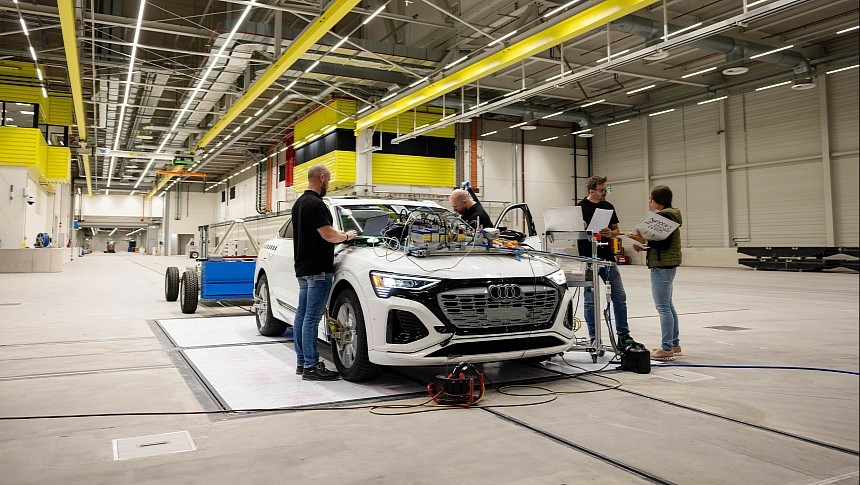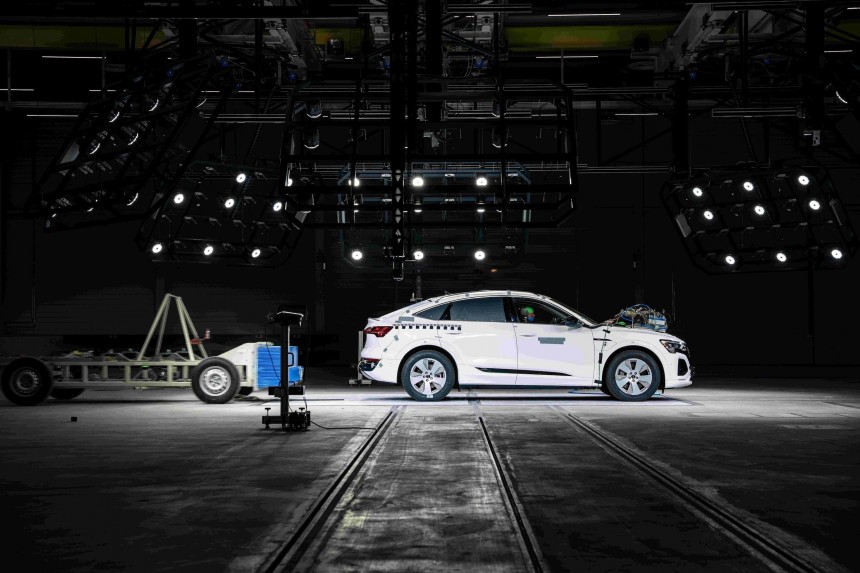Every single carmaker is trying to make their cars safer. And it makes sense, because the safety standards keep getting higher in order to reduce the number of victims caused by accidents or avoid accidents altogether. Audi has just opened a Vehicle Safety Center for that purpose.
The all-new center operates in Ingolstadt, Germany, and Audi invested around 100 million euros ($1.7 million) in the facility that is focused on the development of passive safety systems. It is Audi's most important development facility focused on passive safety. Construction of the establishment took three years. Today, there are approximately 100 people working there.
An 8,230-foot (250-meter) run-up track, a mobile 100-ton crash block and the ability to collide two vehicles at a 90-degree angle are some of the features of the facility. That is how Audi is trying to exceed the current international standards in terms of safety and be one step ahead of changes in the field.
The center covers 130 by 110 meters (430 by 360 feet), and features a height of 20 meters (65 feet), while the support-free area measures 50 by 50 meters (165 by 165 feet). The opposing run-up tracks have 250 meters (820 feet) and enable tests at speeds above the ones used in the independent test. Euro NCAP tests cars against a rigid barrier with full overlap at a speed of 50 kph (31 mph). Meanwhile, NHTSA does the front-crash test with a rigid barrier at 35 mph (56 kph).
Audi also checks how cars react after being run one into another using state-of-the-art technology. The new center in Ingolstadt is also where belt systems and airbags will be developed more efficiently using a coasting slide with a delay unit.
There is also a dummy lab in the safety center, with the Audi safety-specialized team using more than 60 crash test dummies, all equipped with up to 150 sensors, in the new crash arena. The dummies have the sizes of occupants from an 18-month-old toddler to an adult weight 102 kilograms (225 pounds).
Each of the carmaker's vehicles undergo a high double-digit number of test scenarios before it hits the market. Every month, the safety experts carry out tens of thousands of crash simulations even before the first prototype is built. Yet, actual crash tests remain essential.
All the data collected is analyzed in the offices of the facility. High-speed cameras and motion tracking capture the sequences of events during the crash tests. Engineers use 3D scans to digitally process post-test deformations.
Audi conceived the center as a flexible and adaptable facility, that can receive new tech and equipment, depending on the new regulations in the field. The German premium carmaker have achieved top ratings in both active and passive safety tests.
An 8,230-foot (250-meter) run-up track, a mobile 100-ton crash block and the ability to collide two vehicles at a 90-degree angle are some of the features of the facility. That is how Audi is trying to exceed the current international standards in terms of safety and be one step ahead of changes in the field.
The center covers 130 by 110 meters (430 by 360 feet), and features a height of 20 meters (65 feet), while the support-free area measures 50 by 50 meters (165 by 165 feet). The opposing run-up tracks have 250 meters (820 feet) and enable tests at speeds above the ones used in the independent test. Euro NCAP tests cars against a rigid barrier with full overlap at a speed of 50 kph (31 mph). Meanwhile, NHTSA does the front-crash test with a rigid barrier at 35 mph (56 kph).
Audi also checks how cars react after being run one into another using state-of-the-art technology. The new center in Ingolstadt is also where belt systems and airbags will be developed more efficiently using a coasting slide with a delay unit.
Each of the carmaker's vehicles undergo a high double-digit number of test scenarios before it hits the market. Every month, the safety experts carry out tens of thousands of crash simulations even before the first prototype is built. Yet, actual crash tests remain essential.
All the data collected is analyzed in the offices of the facility. High-speed cameras and motion tracking capture the sequences of events during the crash tests. Engineers use 3D scans to digitally process post-test deformations.
Audi conceived the center as a flexible and adaptable facility, that can receive new tech and equipment, depending on the new regulations in the field. The German premium carmaker have achieved top ratings in both active and passive safety tests.












